The itinerary in Turkmenistan was pretty much a straight cut through the desert from the Uzbek border near Dashoguz through to the Iranian border near Ashgabat, stopping at a few relevant places.
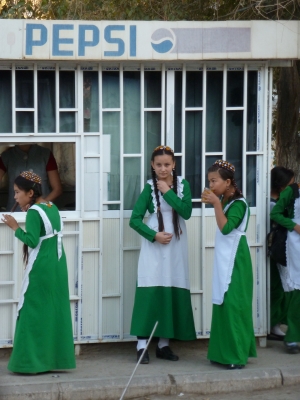
Photo courtesy Derek & Fiona Rendall
Dashoguz: This is one of the largest cities in Turkmenistan. However, since it’s right at the border of Uzbekistan, it sees pretty much no foreign tourists ever. We were only there for a few hours for admin purposes (ie. to get registered with the police). However, in that time we became the spectacle of throngs of locals, especially schoolchildren. Somehow, the city seemed even more Soviet than most places in Uzbekistan or Kyrgyzstan. Perhaps it was because the school uniforms were even more old school. It was also the infrastructure and general vibe of the street. For instance the schoolkids crowding around a permanent metal booth on the street corner to buying some kind of soft drink by the glass reminded me of movies showing Moscow in the 60s. The main difference was satellite dishes: every apartment in Turkmenistan seems to have its own so the roofs of large apartment blocks have hundreds. Even the 3rd most totalitarian country in the world is unable/unwilling to stop people from accessing TV from the outside world.
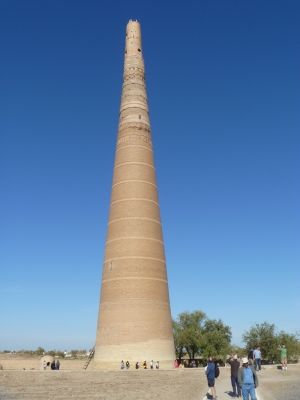 Konye Urgench: meaning “Old Urgench”, this is an ancient capital that was almost fully destroyed by Genghis Khan. Eventually the city became abandoned and people moved to [New] “Urgench” which is across the border in Uzbekistan but quite close. The town is essentially a dozen archaeologically-important buildings located about 100m away from the highway, surrounded by desert. It contains possibly the tallest minaret in Central Asia. It was impressive, as was the fact that it had not collapsed for all those centuries despite the top being seriously tilted. There were people at the top doing restoration — attached by ropes and looking like ants. Right outside another building (one of the most impressive mausoleums I’ve seen), there was a Russian Orthodox cemetery, a reminder of Russian (this time pre-Soviet) colonialism.
Konye Urgench: meaning “Old Urgench”, this is an ancient capital that was almost fully destroyed by Genghis Khan. Eventually the city became abandoned and people moved to [New] “Urgench” which is across the border in Uzbekistan but quite close. The town is essentially a dozen archaeologically-important buildings located about 100m away from the highway, surrounded by desert. It contains possibly the tallest minaret in Central Asia. It was impressive, as was the fact that it had not collapsed for all those centuries despite the top being seriously tilted. There were people at the top doing restoration — attached by ropes and looking like ants. Right outside another building (one of the most impressive mausoleums I’ve seen), there was a Russian Orthodox cemetery, a reminder of Russian (this time pre-Soviet) colonialism.
Darwaza gas crater: Yet another landmark of Soviet environmental mismanagement, this accident has become one of the most iconic sights in the country. When engineers were digging around, they opened up a leak of natural gas in a crater in the middle of the Karakum Desert. They decided to light it, in order to burn off the small amount of gas that was there and continue. The crater has been burning continuously for several decades now. It is other-worldly, especially since it’s so large and sits in the middle of such a poetically-desolate landscape. Walking around it, you feel a very toasty wind. The plans are to contract a Chinese company to fill the crater so as to stop wasting gas. We camped a few km away, near a former village that was apparently removed at Niyazov’s request because he didn’t like the look of it.
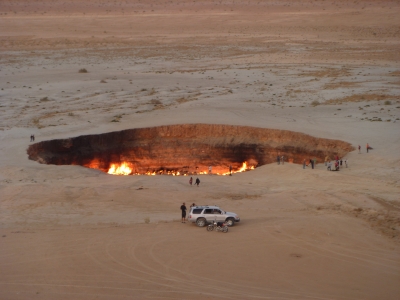
Ashgabat: Ashgabat is probably the most bizarre city I’ve ever been to. On the one hand, it’s quite cosmopolitan and full of the kinds of goods, services and businesses that you’d expect from most capital cities. People go to nightclubs, buy expensive designer shirts if they can and so on. On the other hand, it is centre stage for the country’s repressions which are at times sinister and at times ridiculous. There is an 11pm curfew. There is a host of fantastically-opulent government buildings. We’re talking about lavish fountains, gilded statues, giant palaces made of white marble and so on. Of course, everything is almost entirely empty. You can’t even take a photo though — the one member of staff they always seem to have is a policeman to stop photos — including, ironically, photos of the Ministry of Fairness! Niyazov had taken the false kitsch to the Nth degree by building a giant amusement park and a statue of himself in the central square that revolved to face the sun. Now, Turkmenis are probably a bit embarrassed about all these, so the statue was removed and many similar monuments closed. Which removed the one source of interest for the town. Otherwise, there’s always the giant, empty marble palaces that you can “marvel” at from afar.
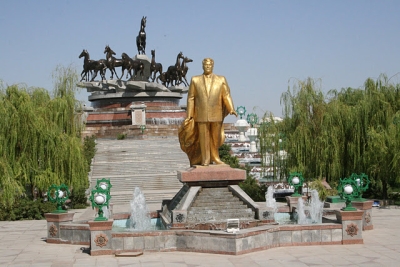
Photo courtesy Alan Chapman

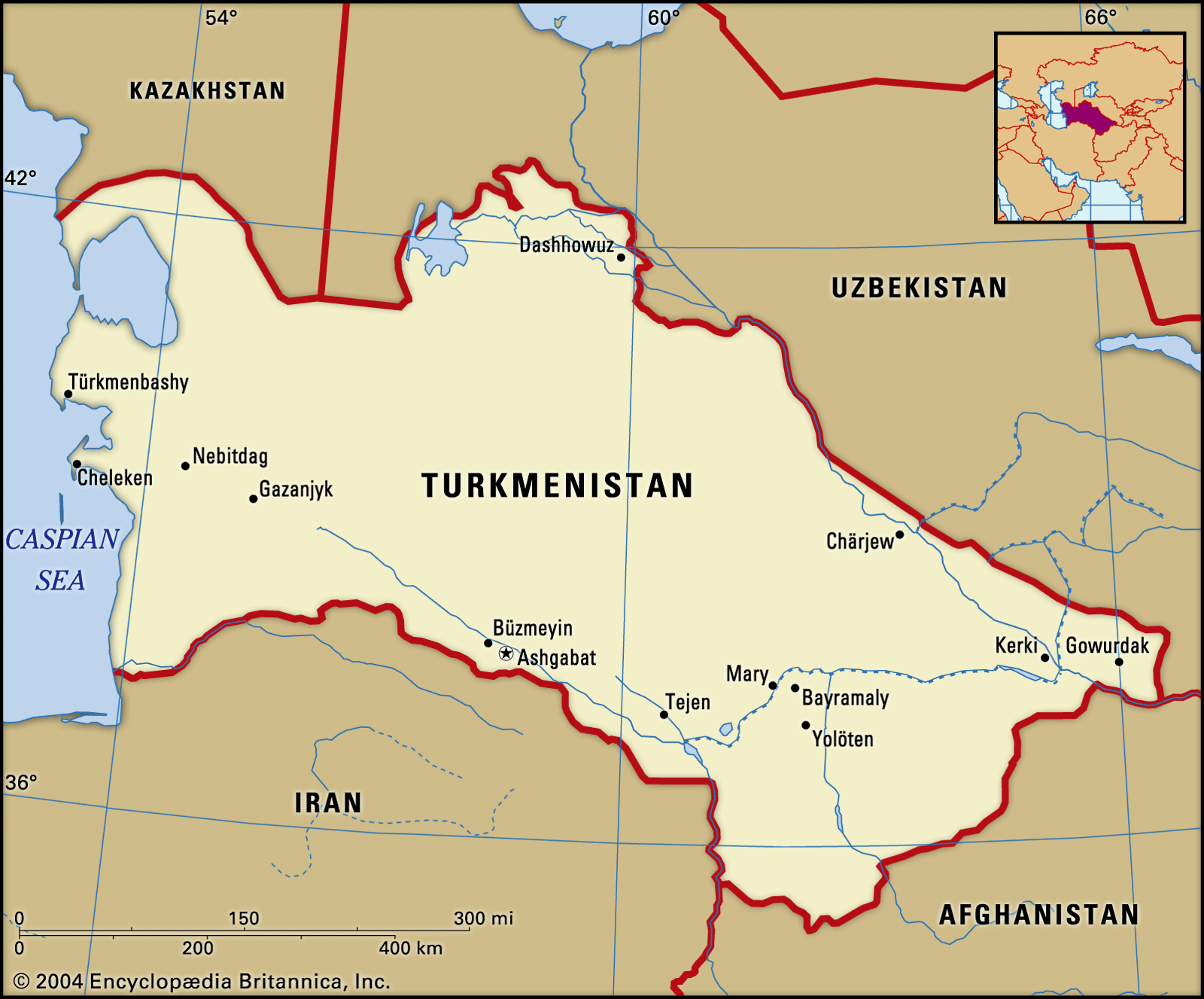
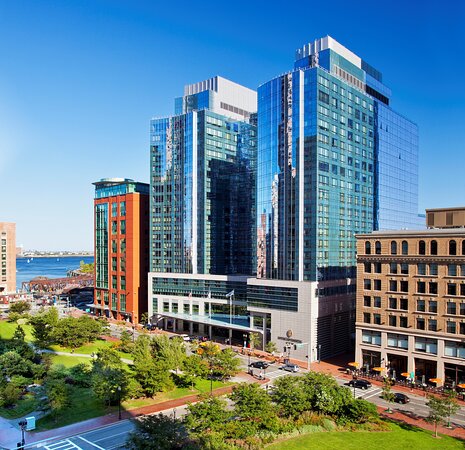

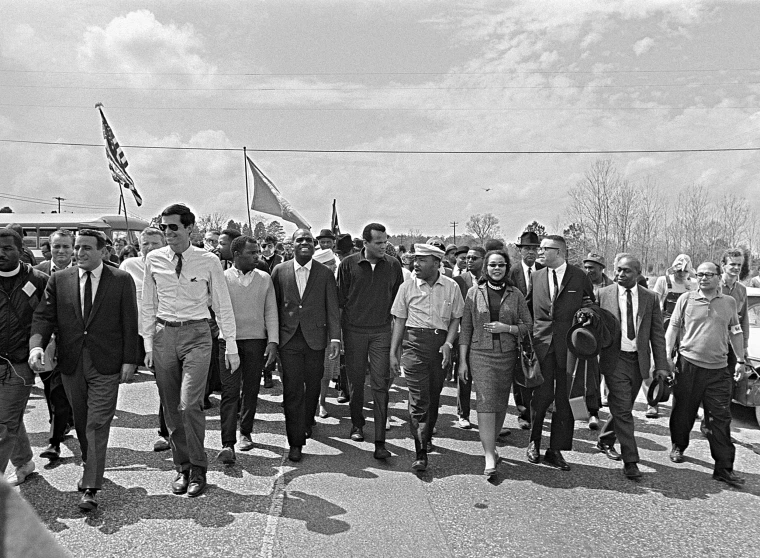
0 Comments